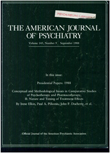Pemoline and urinary excretion of catecholamines and indoleamines in children with attention deficit disorder
Abstract
To test the hypothesis that any change in urinary noradrenergic excretion accompanies drug-induced improvement in attention deficit disorder with hyperactivity, the authors gave pemoline (mean dose, 2.9 mg/kg of body weight) to 11 boys with this disorder in a 4-week open trial. Pemoline administration improved behavior but did not significantly change urinary catecholamine excretion. Serotonin excretion was unchanged, but phenylethylamine (PEA) and 5- hydroxyindoleacetic acid (5-HIAA) were significantly decreased. Clinical responders and nonresponders did not differ with respect to baseline urinary monoamine excretion or change in PEA and 5-HIAA excretion.
Access content
To read the fulltext, please use one of the options below to sign in or purchase access.- Personal login
- Institutional Login
- Sign in via OpenAthens
- Register for access
-
Please login/register if you wish to pair your device and check access availability.
Not a subscriber?
PsychiatryOnline subscription options offer access to the DSM-5 library, books, journals, CME, and patient resources. This all-in-one virtual library provides psychiatrists and mental health professionals with key resources for diagnosis, treatment, research, and professional development.
Need more help? PsychiatryOnline Customer Service may be reached by emailing [email protected] or by calling 800-368-5777 (in the U.S.) or 703-907-7322 (outside the U.S.).



